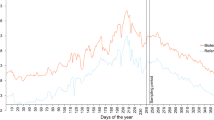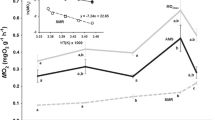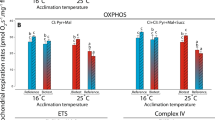Abstract
Temperature and mitochondrial plasticity are well studied in fishes, but little is known about this relationship in invertebrates. The effects of habitat temperature on mitochondrial ultrastructure were examined in three con-familial limpets from the Antarctic (Nacella concinna), New Zealand (Cellana ornata), and Singapore (Cellana radiata). The effects of seasonal changes in temperature were also examined in winter and summer C. ornata. Stereological methods showed that limpet pedal myocytes were 1–2 orders of magnitude smaller in diameter (≈3.5 μm) than in vertebrates, and that the diameter did not vary as a function of temperature. Mitochondrial volume density (Vv(mt,f)) was approximately 2–4 times higher in N. concinna (0.024) than in the other species (0.01 and 0.006), which were not significantly different from each other. Mitochondrial cristae surface density (Sv(im,mt)) was significantly lower in summer C. ornata (24.1 ± 0.50 μm2 μm−3) than both winter C. ornata (32.3 ± 0.95 μm2 μm−3) and N. concinna (34.3 ± 4.43 μm2 μm−3). The surface area of mitochondrial cristae per unit fibre volume was significantly higher in N. concinna, due largely to the greater mitochondrial volume density. These results and previous studies indicate that mitochondrial proliferation in the cold is a common, but not universal response by different species from different thermal habitats. Seasonal temperature decreases on the other hand, leading preferentially to an increase in cristae surface density. Stereological measures also showed that energetic reserves, i.e. lipid droplets and glycogen in the pedal muscle changed greatly with season and species. This was most likely related to gametogenesis and spawning.





Similar content being viewed by others
References
Barry RJC, Munday KA (1959) Carbohydrate levels in Patella. J Mar Biol Assoc UK 38:81–95
Blackmore DT (1969) Studies of Patella vulgata L. II. Seasonal variation in biochemical composition. J Exp Mar Biol Ecol 3:231–245
Boyden CR, Zeldis JR (1979) Preliminary observations using an attached microphonic sensor to study feeding behaviour of an intertidal limpet. Estuar Coast Mar Sci 9:759–769
Chapman G (1958) The hydrostatic skeleton in the invertebrates. Biol Rev 33:338–371
Dunmore RA, Schiel DR (2000) Reproduction in the intertidal limpet Cellana ornata in southern New Zealand. NZ J Mar Freshwater Res 34:653–660
Egginton S, Sidell BD (1989) Thermal acclimation induces adaptive changes in subcellular structure of fish skeletal muscle. Am J Physiol 256:R1–R9
Ellis EA (2002) New embedding formulations using Quetol 651. Microsc Microanal 8:884–885
Fraser KPP, Clarke A, Peck LS (2002) Feast and famine in Antarctica: seasonal physiology in the limpet Nacella concinna. Mar Ecol Prog Ser 242:169–177
Fraser KPP, Clarke A, Peck LS (2007) Growth in the slow lane: protein metabolism in the Antarctic limpet Nacella concinna (Strebel 1908). J Exp Biol 210:2691–2699
Gabbott PA (1976) Energy metabolism. In: Bayne BL (ed) Marine mussels, their ecology and physiology. Cambridge University Press, Cambridge, pp 293–356
Gabbott PA (1983) Developmental and seasonal metabolic activities in marine molluscs. In: Hochachka PW (ed) The mollusca. Academic Press, New York, pp 165–217
Guderley H (2004a) Metabolic responses to low temperature in fish muscle. Biol Rev 79:409–427
Guderley H (2004b) Locomotor performance and muscle metabolic capacities: impact of temperature and energetic status. Comp Biochem Physiol 139B:371–382
Hoppeler H, Lüthi P, Claassen H, Weibel E, Howald H (1973) The ultrastructure of the normal human skeletal muscle. Eur J Physiol 344:217–232
Jastroch M, Buckingham J, Helwig M, Klingenspor M, Brand M (2007) Functional characterisation of UCP1 in the common carp: Uncoupling activity in liver mitochondria and cold-induced expression in the brain. J Comp Physiol B 177:743–752
Johnston IA, Calvo J, Guderley H, Fernandez D, Palmer L (1998) Latitudinal variation in the abundance and oxidative capacities of muscle mitochondria in perciform fishes. J Exp Biol 201:1–12
Jones HD, Trueman ER (1970) Locomotion of the Limpet, Patella vulgata L. J Exp Biol 52:201–216
Kier WM, Smith KK (1985) Tongues, tentacles and trunks: the biomechanics of movement in muscular-hydrostats. Zool J Linnean Soc 83:307–324
Kilarski WM, Romek M, Kozlowska M, Gorlich A (1996) Short-term thermal acclimation induces adaptive changes in the inner mitochondrial membranes of fish skeletal muscle. J Fish Biol 49:1280–1290
Kinsey ST, Hardy KM, Locke BR (2007) The long and winding road: influences of intracellular metabolite diffusion on cellular organization and metabolism in skeletal muscle. J Exp Biol 210:3505–3512
Lawrence JM (1976) Patterns of lipid storage in post-metamorphic marine invertebrates. Am Zool 16:747–762
Lurman GJ, Blaser T, Lamare M, Peck LS, Morley SA (2010) Mitochondrial plasticity in brachiopod (Liothyrella spp.) smooth adductor muscle as a result of season and latitude. Mar Biol 157:907–913
Mark FC, Lucassen M, Portner HO (2006) Thermal sensitivity of uncoupling protein expression in polar and temperate fish. Comp Biochem Physiol 1D:365–374
Marshall DJ, McQuaid CD (1992) Relationship between heart rate and oxygen consumption in the intertidal limpets Patella granularis and Siphonaria oculus. Comp Biochem Physiol 103A:297–300
Morley SA, Lurman G, Skepper JN, Pörtner H-O, Peck LS (2009) Thermal plasticity of mitochondria: a latitudinal comparison between Southern Ocean molluscs. Comp Biochem Physiol 152A:423–430
Mueller M, Breil F, Vogt M, Steiner R, Lippuner K, Popp A, Klossner S, Hoppeler H, Däpp C (2009) Different response to eccentric and concentric training in older men and women. Eur J Appl Physiol 107:145–153
Parry GD (1984) The effect of food deprivation on seasonal changes in the metabolic rate of the limpet, Cellana tramoserica. Comp Biochem Physiol 77A:663–668
Plagényi EE, Branch GM (2000) Does the limpet Patella cochlear fertilize its own algal garden? Mar Ecol Prog Ser 194:113–122
Pörtner HO, van Dijk PLM, Hardewig I, Sommer A (2000) Levels of metabolic cold adaptation: tradeoffs in eurythermal and stenothermal ectotherms. In: Davison W, Williams CH (eds) Antarctic Ecosystems: models for wider ecological understanding. Caxton Press, Christchurch, pp 109–122
Powell DK (2001) The Reproductive ecology of Antarctic free-spawning molluscs. University of Southampton, Southampton
Rao MB (1973) Sex phenomenon and reproductive cycle in the limpet Cellana radiata (Born) (Gastropoda: Prosobranchia). J Exp Mar Biol Ecol 12:263–278
Rao MB (1980) Studies on the oxygen consumption of a tropical intertidal limpet Cellana radiata (Born): effect of body size and tidal rhythm. Hydrobiol 71:175–179
Sänger A (1993) Limits to the acclimation of fish muscle. Rev Fish Biol Fisher 3:1–15
Santini G, De Pirro M, Chelazzi G (1999) In situ and laboratory assessment of heart rate in a mediterranean limpet using a noninvasive technique. Physiol Biochem Zool 72:198–204
Segal E (1956) Microgeographic variation as thermal acclimation in an intertidal mollusc. Biol Bull 111:129–152
Sidell BD (1983) Cellular acclimatisation to environmental change by quantitative alterations in enzymes and organelles. In: Cossins AR, Sheterline P (eds) Cellular acclimatisation to environmental change. Cambridge University Press, London, pp 103–120
Simpson RD (1982) Reproduction and lipids in the sub-Antarctic limpet Nacella (Patinigera) macquariensis Finlay, 1927. J Exp Mar Biol Ecol 56:33–48
Sommer AM, Pörtner HO (2002) Metabolic cold adaptation in the lugworm Arenicola marina: comparison of a North Sea and a White Sea population. Mar Ecol Prog Ser 240:171–182
St-Pierre J, Charest PM, Guderley H (1998) Relative contribution of quantitative and qualitative changes in mitochondria to metabolic compensation during seasonal acclimatisation of rainbow trout Oncorhynchus mykiss. J Exp Biol 201:2961–2970
Stützel R (1984) Anatomische und Ultrastrukturelle Untersuchungen an der Napfschnecke Patella L. unter besonderer Berücksichtigung der Anpassung an den Lebensraum. Scheweizerbart, Stuttgart
Voltzow J (1988) The organization of limpet pedal musculature and its evolutionary implications for the Gastropoda. Malacol Rev 4:273–283
Voltzow J (1990) The functional morphology of the pedal musculature of the marine gastropods Busycon contrarium and Haliotis kamtschatkana. Veliger 33:1–19
Voltzow J (1994) Gastropoda: Prosobranchia. In: Harrison FW, Kohn AJ (eds) Microscopic anatomy of invertebrates, volume 5: Mollusca. Wiley-Liss, New York, pp 111–252
Weibel ER (1979) Stereological methods. Academic Press, London
Acknowledgments
Marianne Hofstetter and Kerstin Meyer are thanked for their assistance during histological preparation. Ruth Vock, Hans Hoppeler, Jean-Michel Weber and Daniela Lurman-Lange are thanked for insightful discussions. This project was financed in part by the ESF ThermAdapt short visit grant (2148) awarded to GL, a Society for Experimental Biology travel grant awarded to GL, a TransAntarctic Association grant awarded to SM, the University of Bern, and funding from the Natural Environment Research Council via the British Antarctic Survey BIOREACH project in the BIOFLAME programme.
Author information
Authors and Affiliations
Corresponding author
Additional information
Communicated by J. P. Grassle.
Rights and permissions
About this article
Cite this article
Lurman, G., Blaser, T., Lamare, M. et al. Ultrastructure of pedal muscle as a function of temperature in nacellid limpets. Mar Biol 157, 1705–1712 (2010). https://doi.org/10.1007/s00227-010-1444-2
Received:
Accepted:
Published:
Issue Date:
DOI: https://doi.org/10.1007/s00227-010-1444-2




